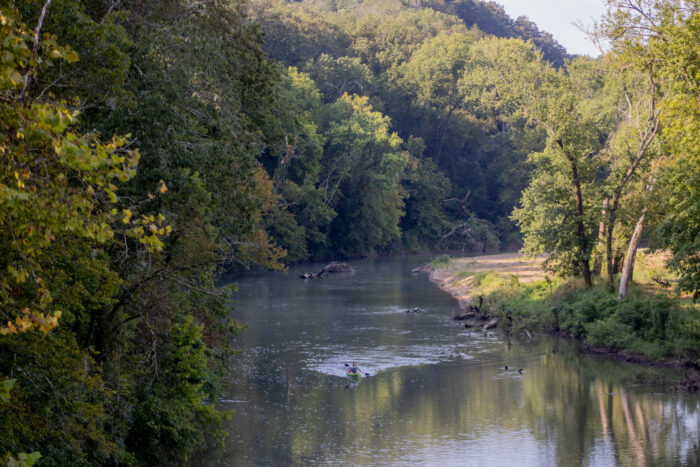Removing bacteria from Middle Tennessee waters
This month, the Southern Environmental Law Center, on behalf of the Harpeth Conservancy, reached a settlement with the Tennessee Department of Environment and Conservation and the Water Authority of Dickson County intended to clean up a large bacteria and algae bloom polluting a waterway in White Bluff, Tenn.
Last year, visitors discovered a putrid bloom of bacteria and algae in Trace Creek, a tributary of the Harpeth River. Sampling revealed sewage-loving bacteria and algae which persisted in the creek for months, filling the waterway with stringy, smelly scum and slime. The bloom formed directly below a discharge pipe from the Water Authority of Dickson County’s White Bluff Wastewater Treatment Plant, and the scum continued downstream for several hundred yards.
The settlement agreement between the Harpeth Conservancy, TDEC, and the Water Authority of Dickson County aims to eliminate the bacteria and algae scum and better protect Trace Creek from pollution in the future. As part of the settlement, the Water Authority of Dickson County commits to undertaking efforts to eliminate the growth in Trace Creek. Representatives from the Harpeth Conservancy, TDEC, and the Water Authority of Dickson County will meet at least four times a year to monitor Trace Creek and discuss operational changes made at the plant.

“This settlement is a major victory for Trace Creek and the people who enjoy it,” SELC Senior Attorney George Nolan said. “This collaborative solution can and should serve as a model of how stakeholders can work together to better protect our state’s incredible waterways from harmful pollution.”
The settlement comes after the Southern Environmental Law Center, on behalf of Harpeth Conservancy, filed an administrative lawsuit demanding that the pollution be stopped. While that case was pending, the Water Authority of Dickson County made operational changes at its sewage treatment plant intended to correct the problem.
Protecting one of the state’s most popular waterways
Trace Creek flows directly into the heart of the Narrows of the Harpeth, an extremely popular and beloved destination for paddlers, tubers, and anglers from across the state. The Harpeth River was once listed as one of America’s most endangered rivers, but in recent years there has been significant progress in improving the health of the Harpeth River. The bacterial growth on Trace Creek threatened to undermine that incredible success story.
“Trace Creek may seem small, but like all small streams it plays a big role in our river systems,” Grace Stranch, CEO of the Harpeth Conservancy, said. “We look forward to working together to restore Trace Creek. These collaborative science-based solutions are central to our mission, and we hope the efforts made to resolve the issue are successful and can be used as a model statewide to prevent similar issues.”
Under the agreement, SELC and the Harpeth Conservancy can take further legal action as necessary to protect Trace Creek in the event that the Water Authority’s efforts to clean up the creek are not successful.
